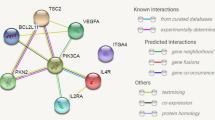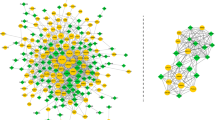Abstract
Parkinson’s disease (PD) is one of the most common neurodegenerative pathologies. This disorder is associated with death of predominantly dopaminergic neurons. A characteristic feature of PD is a long latent period of disease development, which makes it impossible to investigate and diagnose PD at the earliest clinical stages. One of the approaches to solving this problem is the examination of the peripheral blood of untreated PD patients at the early clinical stages. Changes in relative mRNA levels of genes in peripheral blood can be considered as potential biomarkers at the early stages of PD. In this study, we analyzed changes in relative mRNA levels of genes CLN3, GABBR1, and WFS1 in peripheral blood in treated and untreated PD patients and in comparison groups using RT-qPCR with TaqMan probes. All the known functions of the proteins of the studied genes, as well as the identified associations of these genes with various neurological diseases, may indicate their possible involvement in PD pathogenesis. However, no statistically significant changes in mRNA levels in PD patients relative to the control were shown for any gene. No significant changes in relative mRNA levels in the neurological control group were shown either. So, the data presented in this paper suggest that genes CLN3, GABBR1, and WFS1 do not contribute to the pathogenesis of the disease, at least at the mRNA level, at the early symptomatic stages in patients with PD and, therefore, cannot be considered as biomarkers of the early stages of PD.
Similar content being viewed by others
REFERENCES
Del Tredici, K. and Braak, H., Review: Sporadic Parkinson’s disease: Development and distribution of alpha-synuclein pathology, Neuropathol. Appl. Neurobiol., 2016, vol. 42, no. 1, pp. 33–50. https://doi.org/10.1111/nan.12298
Lunati, A., Lesage, S., and Brice, A., The genetic landscape of Parkinson’s disease, Rev. Neurol., 2018, vol. 174, no. 9, pp. 628–643. https://doi.org/10.1016/j.neurol.2018.08.004
Borrageiro, G., Haylett, W., Seedat, S., Kuivaniemi, H., and Bardien, S., A review of genome-wide transcriptomics studies in Parkinson’s disease, Eur. J. Neurosci., 2018, vol. 47, no. 1, pp. 1–16. https://doi.org/10.1111/ejn.13760
Kalia, L.V. and Lang, A.E., Parkinson’s disease, Lancet, 2015, vol. 386, no. 9996, pp. 896–912. https://doi.org/10.1016/s0140-6736(14)61393-3
Goetz, C.G., Poewe, W., Rascol, O., Sampaio, C., Stebbins, G.T., Counsell, C., et al., Movement Disorder Society Task Force report on the Hoehn and Yahr staging scale: Status and recommendations, Mov. Disord., 2004, vol. 19, no. 9, pp. 1020–1028. https://doi.org/10.1002/mds.20213
Suslov, O. and Steindler, D.A., PCR inhibition by reverse transcriptase leads to an overestimation of amplification efficiency, Nucleic Acids Res., 2005, vol. 33, no. 20, p. e181. https://doi.org/10.1093/nar/gni176
Livak, K.J. and Schmittgen, T.D., Analysis of relative gene expression data using real-time quantitative PCR and the 2(–Delta Delta C(T)) Method, Methods, 2001, vol. 25, no. 4, pp. 402–408. https://doi.org/10.1006/meth.2001.1262
Alieva, A.K., Shadrina, M.I., Filatova, E.V., Karabanov, A.V., Illarioshkin, S.N., Limborska, S.A., et al., Involvement of endocytosis and alternative splicing in the formation of the pathological process in the early stages of Parkinson’s disease, BioMed Res. Int., 2014, vol. 2014, article ID 718732. https://doi.org/10.1155/2014/718732
Shadrina, M., Nikopensius, T., Slominsky, P., Illarioshkin, S., Bagyeva, G., Markova, E., et al., Association study of sporadic Parkinson’s disease genetic risk factors in patients from Russia by APEX technology, Neurosci. Lett., 2006, vol. 405, no. 3, pp. 212–216. https://doi.org/10.1016/j.neulet.2006.06.066
Chandrachud, U., Walker, M.W., Simas, A.M., Heetveld, S., Petcherski, A., Klein, M., et al., Unbiased cell-based screening in a neuronal cell model of batten disease highlights an interaction between Ca2+ homeostasis, autophagy, and CLN3 protein function, J. Biol. Chem., 2015, vol. 290, no. 23, pp. 14 361–14 380. https://doi.org/10.1074/jbc.M114.621706
Phillips, S.N., Benedict, J.W., Weimer, J.M., Pearce, D.A., et al., CLN3, the protein associated with batten disease: Structure, function and localization, J. Neurosci. Res., 2005, vol. 79, no. 5, pp. 573–583. https://doi.org/10.1002/jnr.20367
Perland, E., Bagchi, S., Klaesson, A., Fredriksson, R., et al., Characteristics of 29 novel atypical solute carriers of major facilitator superfamily type: Evolutionary conservation, predicted structure and neuronal co-expression, Open Biol., 2017, vol. 7, no. 9, pp. 170 142–170 157. https://doi.org/10.1098/rsob.170142
Tuxworth, R.I., Chen, H., Vivancos, V., Carvajal, N., Huang, X., and Tear, G., The Batten disease gene CLN3 is required for the response to oxidative stress, Hum. Mol. Genet., 2011, vol. 20, no. 10, pp. 2037–2047. https://doi.org/10.1093/hmg/ddr088
Nuzhnyi, E.P., Yakimovskii, A.F., Timofeeva, A.A., Usenko, T.S., Nikolaev, M.A., Emel’yanov, A.K., et al., Mutation del 1.02 kb in the CLN3 gene and extrapyramidal syndrome, Zh. Nevrol. Psikhiatr. im. S. S. Korsakova, 2016, vol. 116, no. 8, pp. 50–53. https://doi.org/10.17116/jnevro20161168150-53
Chalifoux, J.R. and Carter, A.G., GABAB receptors modulate NMDA receptor calcium signals in dendritic spines, Neuron, 2010, vol. 66, no. 1, pp. 101–113. https://doi.org/10.1016/j.neuron.2010.03.012
Chalifoux, J.R. and Carter, A.G., GABAB receptor modulation of synaptic function, Curr. Opin. Neurobiol., 2011, vol. 21, no. 2, pp. 339–344. https://doi.org/10.1016/j.conb.2011.02.004
Galvan, A., Eftekhari, S., Cloarec, R., Gouty-Colomer, L.A., Dufour, A., and Riffault, B., Localization and pharmacological modulation of GABA-B receptors in the globus pallidus of parkinsonian monkeys, Exp. Neurol., 2011, vol. 229, no. 2, pp. 429–439. https://doi.org/10.1016/j.expneurol.2011.03.010
Lozovaya, N., Eftekhari, S., Cloarec, R., Gouty-Colomer, L.A., Dufour, A., Riffault, B., et al., GABAergic inhibition in dual-transmission cholinergic and GABAergic striatal interneurons is abolished in Parkinson disease, Nat. Commun., 2018, vol. 9, no. 1, p. 1422. https://doi.org/10.1038/s41467-018-03802-y
Wang, Q., Li, W.X., Dai, S.X., Guo, Y.C., Han, F.F., Zheng, J.J., et al., Meta-analysis of Parkinson’s disease and Alzheimer’s disease revealed commonly impaired pathways and dysregulation of NRF2-dependent genes, J. Alzheimer’s Dis., 2017, vol. 56, no. 4, pp. 1525–1539. https://doi.org/10.3233/jad-161032
Takeda, K., Inoue, H., Tanizawa, Y., Matsuzaki, Y., Oba, J., Watanabe, Y., et al., WFS1 (Wolfram syndrome 1) gene product: Predominant subcellular localization to endoplasmic reticulum in cultured cells and neuronal expression in rat brain, Hum. Mol. Genet., 2001, vol. 10, no. 5, pp. 477–484. https://doi.org/10.1093/hmg/10.5.477
Takei, D., Ishihara, H., Yamaguchi, S., Yamada, T., Tamura, A., Katagiri, H., et al., WFS1 protein modulates the free Ca2+ concentration in the endoplasmic reticulum, FEBS Lett., 2006, vol. 580, no. 24, pp. 5635–5640. https://doi.org/10.1016/j.febslet.2006.09.007
Osman, A.A., Saito, M., Makepeace, C., Permutt, M.A., Schlesinger, P., and Mueckler, M., Wolframin expression induces novel ion channel activity in endoplasmic reticulum membranes and increases intracellular calcium, J. Biol. Chem., 2003, vol. 278, no. 52, pp. 52 755–52 762. https://doi.org/10.1074/jbc.M310331200
Fonseca, S.G., Fukuma, M., Lipson, K.L., Nguyen, L.X., Allen, J.R., Oka, Y., et al., WFS1 is a novel component of the unfolded protein response and maintains homeostasis of the endoplasmic reticulum in pancreatic beta-cells, J. Biol. Chem., 2005, vol. 280, no. 47, pp. 39 609–39 615. https://doi.org/10.1074/jbc.M507426200
Sakakibara, Y., Sekiya, M., Fujisaki, N., Quan, X., and Iijima, K.M., Knockdown of wfs1, a fly homolog of Wolfram syndrome 1, in the nervous system increases susceptibility to age- and stress-induced neuronal dysfunction and degeneration in Drosophila, PLoS Genet., 2018, vol. 14, no. 1, p. e1 007 196. https://doi.org/10.1371/journal.pgen.1007196
Shadrina, M., Filatova, E., Alieva, A., Stavrovskaya, A., Khudoerkov, R., Limborska, S., et al., Transcriptome profiling of 6-OHDA model of Parkinson’s disease, Adv. Biosci. Biotechnol., 2013, vol. 4, pp. 28–35. https://doi.org/10.4236/abb.2013.46A005
Funding
This work was supported by the Russian Science Foundation, no. 17-75-10119. The work was carried out using the instruments of the Center for Genetic and Cellular Technologies Center for Collective Use of the Institute of Molecular Genetics of the Russian Academy of Sciences.
Author information
Authors and Affiliations
Corresponding author
Ethics declarations
COMPLIANCE WITH ETHICAL STANDARDS
Conflict of interest. The authors declare that they have no conflict of interest.
Statement of compliance with standards of research involving humans as subjects. All blood samples were taken with the informed consent of the subjects. The study was approved by the Ethics Committee of the Scientific Center of Neurology of the Russian Academy of Sciences.
ADDITIONAL INFORMATION
Starovatykh Yu.S.—e-mail: iggdrasil247@gmail.com; https://orcid.org/0000-0001-6646-886X
Rudenok M.M.—e-mail: margaritamrudenok@gmail.com; https://orcid.org/0000-0003-4739-5460
Karabanov A.V.—e-mail: doctor.karabanov@mail.ru; https://orcid.org/0000-0003-0795-9743
Illarioshkin S.N.—e-mail: snillario@gmail.com; https://orcid.org/0000-0002-2704-6282
Slominsky P.A.—e-mail: slomin@img.ras.ru; https://orcid.org/0000-0002-4112-2368
Shadrina M.I.—e-mail: shadrina@img.ras.ru; https://orcid.org/0000-0002-9977-043X
Alieva A.Kh.—e-mail: anelja.a@gmail.com; https://orcid.org/0000-0002-6200-4491
Additional information
Translated by K. Lazarev
About this article
Cite this article
Starovatykh, Y.S., Rudenok, M.M., Karabanov, A.V. et al. Analysis of Expression of Genes CLN3, GABBR1, and WFS1 in Patients with Parkinson’s Disease. Mol. Genet. Microbiol. Virol. 35, 85–89 (2020). https://doi.org/10.3103/S089141682002010X
Received:
Revised:
Accepted:
Published:
Issue Date:
DOI: https://doi.org/10.3103/S089141682002010X




